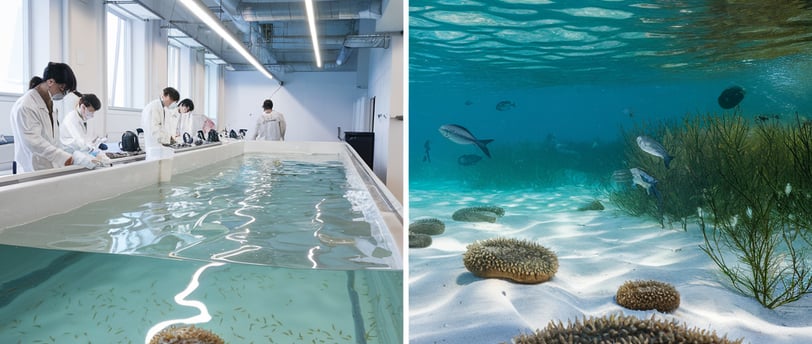Discover the Wonders of Sea Cucumbers
12/17/20244 min read


The Hidden Treasure of the Ocean
When you think of seafood, what comes to mind? Chances are, sea cucumbers aren't the first thing you picture. Yet, these unusual marine animals have been a prized delicacy in many Asian cuisines for centuries. But there's more to these creatures than meets the eye. Sea cucumbers are not only a culinary delight but also play a crucial role in marine ecosystems and sustainable aquaculture practices.
What Exactly Are Sea Cucumbers?
Before we dive into their journey from the ocean floor to our dinner plates, let's get to know these fascinating creatures a bit better.
Sea cucumbers are echinoderms, relatives of starfish and sea urchins. They're named for their cucumber-like shape and can be found in nearly every part of the ocean, from shallow coastal areas to the deepest trenches. These soft-bodied animals come in various sizes and colors, ranging from a few inches to several feet in length.
Ecological Importance
Sea cucumbers are often called the "vacuum cleaners" of the ocean floor.
They help recycle nutrients by consuming and breaking down organic matter.
Their feeding habits help oxygenate the sediment, benefiting other marine life.
The Rise of Sea Cucumber Aquaculture
As the demand for sea cucumbers has grown, especially in Asian markets, wild populations have faced increasing pressure. This has led to the development of sea cucumber aquaculture, a practice that's gaining momentum in the sustainable seafood industry.
Why Sea Cucumber Farming?
Sustainable aquaculture of sea cucumbers offers several benefits:
Reduces pressure on wild populations
Provides a consistent supply for the market
Offers economic opportunities for coastal communities
Contributes to marine ecosystem health when done responsibly
The Journey from Ocean to Plate
Now, let's follow the fascinating journey of sea cucumbers from their natural habitat to our dinner tables.
Wild Harvesting
Traditionally, sea cucumbers were harvested from the wild. Divers would collect them by hand from the ocean floor. This method, while simple, can lead to overfishing if not carefully managed.
Aquaculture Methods
Modern sea cucumber farming typically involves these steps:
Hatchery Phase: Adult sea cucumbers are induced to spawn in controlled conditions. The resulting larvae are carefully nurtured until they settle and transform into juveniles.
Nursery Phase: Young sea cucumbers are transferred to nursery ponds or tanks where they're fed and protected until they reach a suitable size for grow-out.
Grow-out Phase: The juvenile sea cucumbers are moved to larger ponds, tanks, or even released into managed areas of the ocean to grow to market size.
Harvesting: Once they reach the desired size, usually after 12-18 months, the sea cucumbers are harvested.
Processing and Preparation
After harvesting, sea cucumbers undergo several processing steps:
Cleaning and gutting
Boiling to remove the outer layer
Smoking or drying to preserve the product
"The processing of sea cucumbers is as much an art as it is a science, with techniques passed down through generations." - Marine Biologist Dr. Jane Smith
The Culinary World of Sea Cucumbers
Sea cucumbers are prized in many Asian cuisines for their unique texture and ability to absorb flavors. They're often rehydrated and used in soups, stews, and stir-fries. In Chinese cuisine, they're considered one of the "four treasures of the sea" alongside abalone, fish maw, and shark fin.
Nutritional Value
Sea cucumbers are not just a delicacy; they're also nutritious:
Low in fat
High in protein
Rich in vitamins and minerals
Contains compounds with potential health benefits
Challenges and Future of Sea Cucumber Aquaculture
While sea cucumber farming shows promise, it's not without challenges:
Disease Management: Like any form of aquaculture, sea cucumber farms can face disease outbreaks.
Environmental Impact: Poorly managed farms can negatively impact local ecosystems.
Market Fluctuations: The price of sea cucumbers can be volatile, affecting the economic viability of farms.
Technological Advancements: Ongoing research is needed to improve farming techniques and increase sustainability.
Sustainable Practices in Sea Cucumber Aquaculture
To address these challenges and ensure the long-term viability of sea cucumber aquaculture, several sustainable practices are being implemented:
Integrated Multi-Trophic Aquaculture (IMTA): This approach involves farming sea cucumbers alongside other species like fish or shellfish. The sea cucumbers consume the waste produced by the other species, helping to clean the water and reduce environmental impact.
Habitat Conservation: Some farms are designed to mimic natural sea cucumber habitats, providing benefits to local ecosystems.
Genetic Diversity: Maintaining genetic diversity in farmed populations is crucial for the health and resilience of sea cucumber stocks.
Community Involvement: Many successful sea cucumber farming projects involve local communities, providing economic benefits and ensuring traditional knowledge is incorporated into modern practices.
Conclusion: A Sea Change in Aquaculture
The journey of sea cucumbers from ocean floor to dinner plate is a testament to human ingenuity and the potential of sustainable aquaculture. As we continue to face challenges in global food security and marine conservation, the humble sea cucumber offers a unique solution.
By embracing sustainable aquaculture practices, we can enjoy these culinary delights while also protecting wild populations and supporting marine ecosystems. The next time you encounter sea cucumber on a menu, you'll have a new appreciation for the incredible journey it's taken to reach your plate.
As consumers, we play a crucial role in supporting sustainable aquaculture. By choosing responsibly farmed sea cucumbers, we can contribute to the health of our oceans and the communities that depend on them. The story of sea cucumber aquaculture reminds us that sustainability and culinary tradition can go hand in hand, offering a taste of the sea that we can enjoy for generations to come.




